KAYACELON REACT™ Reactive Dye
KAYACELON REACT™ Reactive Dye Advantages:
One-Bath Neutral Dyeing System Saves Time, Money, and Natural Resources
- Shortens and simplifies the dyeing cycle.
- Reduces your chemical usage.
- Conserves valuable water and energy.
- Improves effluent and reduces waste treatment.
- Improves reproducibility and reduces reworks.
- Enhances strength and appearance of fabric.
KAYACELON REACT™ Reactive Dye | Chlorinated Water | Crock Fastness | Perspiration Fastness (Acid) | Wash Fastness 4A | Xenon Light Fastness | Affinity | Solubility 80°C 50°C |
KAYACELON REACT™ | Weak 4 Strong 3-4 | Dry 5 Wet 3-4 | Alteration 4-5 Cotton Stain 5 | Alteration 4-5 Cotton Stain 5 | Light 4 Heavy 4-5 | Low | 70 g/l 100 g/l |
KAYACELON REACT™ | Weak 4-5 Strong 4-5 | Dry 5 Wet 3 | Alteration 4-5 Cotton Stain 5 | Alteration 4-5 Cotton Stain 5 | Light 4-5 Heavy 4-5 | Moderate | 70 g/l 20 g/l |
KAYACELON REACT™ | Weak 4-5 Strong 4-5 | Dry 4-5 Wet 3 | Alteration 4-5 Cotton Stain 5 | Alteration 4-5 Cotton Stain 4-5 | Light 4-5 Heavy 5 | Moderate | 100 g/l 20 g/l |
KAYACELON REACT™ | Weak 4-5 Strong 4 | Dry 5 Wet 2-3 | Alteration 4-5 Cotton Stain 5 | Alteration 4-5 Cotton Stain 5 | Light 4-5 Heavy 5 | High | 50 g/l 10 g/l |
KAYACELON REACT™ 2.0% | Weak 4-5 Strong 4-5 | Dry 4-5 Wet 3 | Alteration 4-5 Cotton Stain 5 | Alteration 4-5 Cotton Stain 4-5 | Light 4-5 Heavy 5 | Moderate | 60 g/l 20 g/l |
KAYACELON REACT™ 2.0% | Weak 4-5 Strong 4-5 | Dry 4 Wet 3 | Alteration 4-5 Cotton Stain 5 | Alteration 4-5 Cotton Stain 4-5 | Light 4-5 Heavy – | Moderate | 100 g/l 60 g/l |
KAYACELON REACT™ 2.0% | Weak 4-5 Strong 4 | Dry 4 Wet 2-3 | Alteration 4-5 Cotton Stain 5 | Alteration 4-5 Cotton Stain 5 | Light 3-4 Heavy 4 | Moderate | 100 g/l 70 g/l |
KAYACELON REACT™ 2.0% | Weak 4-5 Strong 4 | Dry 4-5 Wet 2-3 | Alteration 4-5 Cotton Stain 5 | Alteration 4-5 Cotton Stain 3-4 | Light 3-4 Heavy 4 | High | 100 g/l 70 g/l |
KAYACELON REACT™ 2.0% | Weak 4 Strong 3-4 | Dry 4-5 Wet 3-4 | Alteration 4-5 Cotton Stain 5 | Alteration 4-5 Cotton Stain 4-5 | Light 4-5 Heavy 4-5 | Low | 100 g/l 70 g/l |
KAYACELON REACT™ 2.0% | Weak 4-5 Strong 4 | Dry 5 Wet 2-3 | Alteration 4-5 Cotton Stain 5 | Alteration 4-5 Cotton Stain 4 | Light 3-4 Heavy 4 | Moderate | 100 g/l 70 g/l |
KAYACELON REACT™ 2.0% | Weak 4 Strong 3-4 | Dry 4 Wet 2-3 | Alteration 4-5 Cotton Stain 5 | Alteration 4-5 Cotton Stain 4 | Light – Heavy 3-4 | High | 100 g/l 70 g/l |
KAYACELON REACT™ CN-2G 2.0% | Weak 4-5 Strong 3-4 Y | Dry 5 Wet 2-3 | Alteration 4-5 Cotton Stain 5 | Alteration 4-5 Cotton Stain 3-4 | Light 3-4 Heavy 4 | Low | 100 g/l 70 g/l |
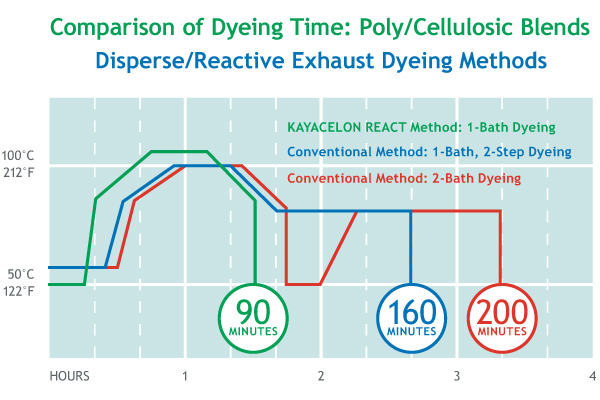
One-Bath System Reduces Dyeing Time Up To 50%
Lower your energy consumption
Simplified system requires fewer steps, uses less water and conserves resourcesNo alkali is required for fixation which eliminates 2-3 rinse cycles
Complete addition of chemicals early in the dyeing cycle
Shorter dye cycle drastically reduces demand on utilities for heat and power
Reduce your chemical usage
Neutral dyes release Niacin (vitamin B3) instead of hydrochloric acidCleaner effluent quality means reduced wastewater treatment
Only one electrolyte and one buffer needed to maintain pH
Improve the appearance and tensile strength of cellulosic fibers
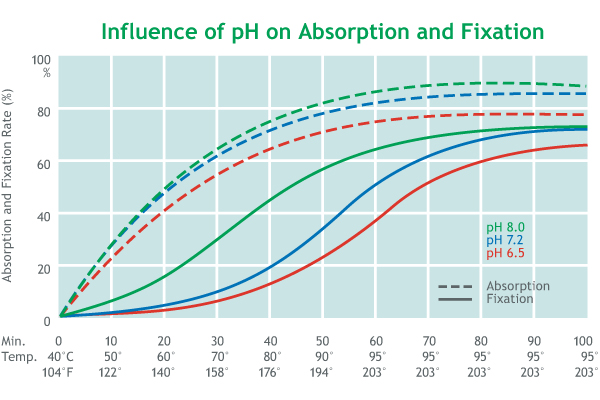
Excellent Performance in a Wide Range of Conditions
Improve reproducibility
KAYACELON REACT dyes have lower sensitivity to dyehouse variables which improves lot-to-lot reproducibilityBetter reproducibility reduces the need for reworks, lowers labor and utility costs and increases your productivity
Enhance fabric appearance
Harsher Monochlorotriazine hot-dyeing reactives can degrade the tensile strength of cellulosic fibersKAYACELON REACT dyes actually improve tensile strength and enhance the feel and appearance of fabric
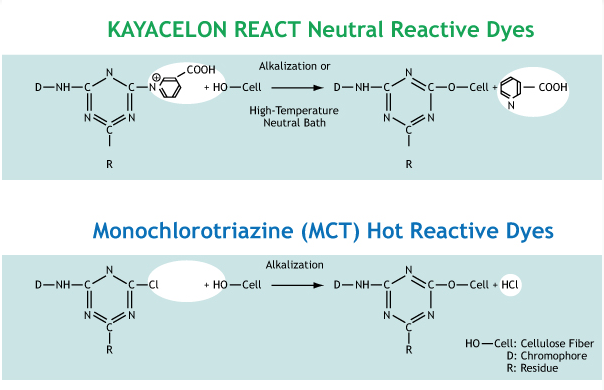
Neutral Dyes Release No Hydrochloric Acid
KAYACELON REACT dyes have the same shade, colorfastness and binding strength as monochlorotriazine (MCT) hot dyeing type reactive dyes because they contain the identical chromophore.The difference is that the reactive group 3-Carboxy pyridinio-s-triazine is used in place of chlorine.
At the end of the cycle, KAYACELON REACT dyes release nicotinic acid (Niacin) which is the water-soluble vitamin B3.
Conventional MCT reactive dyes release hydrochloric acid which must be neutralized in the wastewater treatment area before discharge into the effluent.
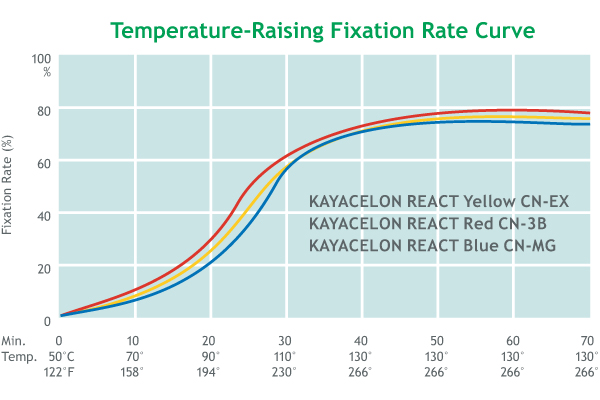
Proven Trichromy Has High Fixation and Exhaustion
KAYACELON REACT Yellow CN-EX
A neutral yellow with good fastness propertiesKAYACELON REACT Red CN-3B
An economical yellow-red with excellent leveling and building propertiesGood for package dyeing
Good in combination with Yellow CN-RL to make economical medium-to-heavy scarlet shades
KAYACELON REACT Blue CN-MG
A neutral blue with good leveling and fastness propertiesGood for light to medium shades
Procedure: High Temp Dyeing of 100% Cotton
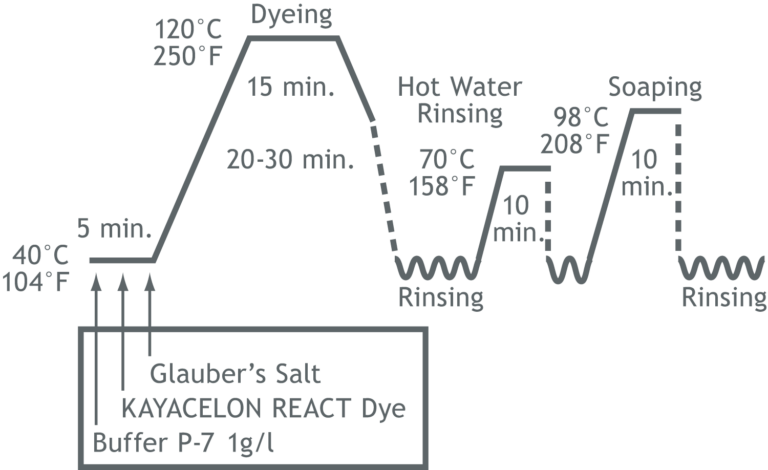
- Set bath at 110ºF with:
- 1.0g/l Buffer P-7
- 0.5g/l Sequestering Agent (if needed)
- Run 5 minutes.
- Add pre-dissolved KAYACELON REACT™ Dye (dissolve at 180ºF).
- Run 10-minutes.
- Add 1/10 total amount of sodium sulfate.
- Run 10-minutes.
- Add remaining 9/10 of sodium sulfate.
- Check pH (6.5-7.5) and salt concentration.
- Heat to 250ºF at 3-5ºF/minute
- Run 15-20 minutes, depending on the depth of shade.
- Cool to 170ºF. Sample.
- If shade is acceptable, drop bath.
- Fill and heat to 140ºF, run 10-minutes. Drop Bath.
- Fill hot and add:
- Xg/l Scouring Agent
- Heat to 200º, run 10-minutes. Cool and drop bath.
- Fill and heat to 140º, run 10-minutes. Drop Bath.
- Rinse until clear, unload.
Sodium Sulfate Table
Dye (%) | Cotton (g/l) | Rayon (g/l) |
|---|---|---|
0.00-0.15 | 10 | 7 |
0.16-0.25 | 15 | 10 |
0.26-0.50 | 20 | 15 |
0.51-0.75 | 30 | 20 |
0.76-1.00 | 40 | 30 |
1.01-1.50 | 50 | 35 |
1.51-2.00 | 60 | 40 |
2.01-2.50 | 70 | 50 |
2.51 or over | 80 | 60 |
If brine or common salt is used, the recommended amount is 70% of the amount illustrated in the table above.
Buffer P-7:
Properties
Appearance: White Powder
Composition: Mixture of Phosphates
pH: 6.5 (1.0 g/l aqueous solution with 40 g/l of Glauber’s salt)
Solubility: Dissolves Easy in Warm Water
Characteristics
- pH of 6.8-7.2 is produced in a dyebath containing Glauber’s salt.
- Especially useful for one-bath dyeing of 100% cotton with KAYACELON REACT™ Dye.
Usage
- Add 1.0g/l to the dyebath for dyeing with KAYACELON REACT™ Reactive Dye.
- Neutralization in advance is required if strong alkali or acid is used for pretreatment.

